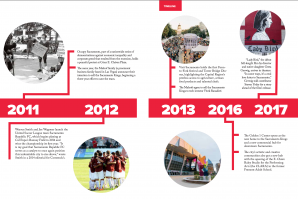Robert Watson stands beneath an ornate capital, many of which
were meticulously reconstructed under his ownership. (Photos by
Dominic Tassinari)

“Humanity uniting effectively” — that’s been the mantra and lifelong passion of Robert Watson, whose nonprofit Resolution Institute fosters teamwork to solve big problems. As the current resident at 2100 F Street in Midtown, Watson has woven this theme into the bones of the iconic property.
While looking for contractors for a restoration of his front porch and balcony in 2019, Watson observed the interaction between one contractor, his structural engineer and his carpenter as they struggled to find a practical solution that would honor the architectural splendor of the property. After a spirited debate, the group realized the carpenter had come up with a creative idea to solve the problem to perfection. Watson was thrilled to witness the synergy he so ardently promotes, and he hired them on the spot.
The entryway and stairwell showcase original woodwork.

The home’s exquisite doorbell.

2100 F Street was built in the then-newly developed Boulevard Park in 1911 for retired cattle baron and banker Joseph Marzen and his wife, Catherine. Architects Seadler and Hoen designed it, as well as the equally striking childhood home of writer Joan Didion in Poverty Ridge that same year.
The Boulevard Park Historic District, with about 300 buildings, is the largest neighborhood in Sacramento on the National Register of Historic Places; but after its heyday, the area fell into disrepair as wealthy families moved on to more suburban locales. The once stately mansions were commonly converted into boarding houses and other businesses. Then, in the 1970s, there was an upsurge of interest in historic preservation, and a neighborhood transformation began anew.
In the ensuing years, the four-bedroom, three-bath, 3,746 square-foot home became known as the Fitzpatrick House. Bonnie Fitzpatrick, a renowned realtor and passionate preservationist, purchased the subdivided home in 1979 and restored it to its former grandeur as a single-family residence. She sold the home in 2000 to Watson and his then-wife, Molly Hansen.
A distinctive porthole window is tucked away in one of the
upstairs bedroom closets.

The interior of the home, especially the extensive original woodwork and the antique light fixtures, reflect Fitzpatrick’s meticulous preservation efforts. The entry hall makes a grand impression. To the right, as you enter, is the imposing staircase, which faces a living room that features an original brick fireplace. Adjacent to the living room is the dining room with leaded glass built-ins, and beyond that, at the back of the house, is a large and more modern kitchen, breakfast nook and family room, which were most likely added on later. In the kitchen, Fitzpatrick installed a rare red enamel 1948 O’Keefe & Merritt gas stove. At the upstairs landing is a “fainting lounge,” where, some say, ladies in tight corsets would rest after ascending the stairs. It serves as a zen sitting area today.
The kitchen features a red enamel 1948 O’Keefe & Merritt gas
stove and a butler’s pantry.

Watson, 74, views himself as a steward of the home. He appreciates his connection to Fitzpatrick, who shared many details about the property and became a friend before she died in 2008. Although she conducted most of the major renovations, Watson found that his favorite spot, the serene, tree-shaded balcony at the front of the house, was in need of serious repairs. This led to a brilliant restoration of arguably the most distinctive and beautiful feature of the home: the supporting columns and capitals, which reflect a masterful blend of classical, arts and crafts, and art nouveau influences.
The contractor for this project, Mike Mack, of Mack Construction, specializes in historic home restoration and is currently working on several of these properties downtown. “We take great pride in our work. We’ll take on any problem. We brainstorm, and if we haven’t done it, we’ll figure it out,” Mack says. Admirably, he gives his employee and friend, carpenter and general contractor Tim Butler, all the credit for the success of the F Street project. Repairing those porch columns, Butler says, “was a challenge. We had to be creative to keep it beautiful and within budget.” He designed a system with columns that open up so that the interior support can be adjusted to account for sagging over time.
Watson collects historical photos and articles pertaining to the
house.

A polyurethane mold was used to cast new plaster capitals.

For the exquisite capitals atop the columns, Butler used a Dremel tool to painstakingly remove decades of thick paint while preserving the original plaster pinecones, flourishes, and egg and dart details. He then made a polyurethane mold to cast new plaster capitals in four pieces, 28 in total for seven columns. He researched plaster density so that the finished product would endure for decades to come.
The Marzen/Fitzpatrick/Watson House is a testament to collaboration and stewardship spanning over a century. The current community of preservationists and craftspeople are a passionate bunch who all seem to know each other. The home is in good hands.
2100 F Street will be featured on Preservation Sacramento’s Historic Home Tour on Sept. 22. Tickets are available now on their website.
Kendall Morlan is a Calaveras County-based writer with a background in design.
–
Stay up to date on business in the Capital Region: Subscribe to the Comstock’s newsletter today.
Recommended For You

Where We’ve Been
A timeline of notable events in the Capital Region over the past 35 years
Comstock’s magazine has lived through more than three decades of milestones in the Capital Region. We dived into the stacks and reached out to local experts, including State Historian William Burg and City Historian Marcia Eymann, to highlight a few key moments we’ve made it through.

The Great Migration
From immigrants fleeing their countries to Bay Area residents escaping high prices, the culture of the Capital Region is changing
Just under 2.4 million people live in the Sacramento-Roseville-Folsom metropolitan area, an increase of roughly a quarter since the turn of the century.

A Day in the Life of Comstock’s Publisher
Winnie Comstock-Carlson describes an average weekday as this magazine’s founder, president and publisher (for 35 years).

Building the Future
Veteran architects are essential in mentoring young, emerging designers
The field of architecture is changing, and technology is playing a central role, but it’s not the only element that’s shifting: so is the expectation of what young and emerging professionals are looking for in an architectural job.

Guitar Exhibit Links Music to History
California guitar manufacturers get special focus
Heads up, guitar geeks and music freaks: A Sacramento museum has gone a little bit rock ‘n’ roll — at least for the summer.









